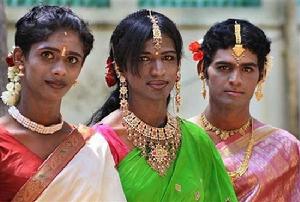what is Hijra?
Hijra was known as eunuch in English, in traditionally, some boys between the ages of 10 and 15 has been boycotted by formal religious rituals to become an eunuch in India.Hijra are a third sex category similar to other such groups in many cultures (Boellstorff, 2003; Chinas,1992; Jackson, 2003; Manalansan, 2003; Vasey & Bartlett, 2007).Their primary job is to marry funeral wedding occasion for the owner of the blessing, Exorcism evils. These people have to maintain their own ethics strictly, they can not drink and use drugs, also do not go to a regular hospital for medical treatment and do not make friends with outsiders. If you want to be “Hijra”, you must get agreement with yourself and your family.As long as the two sides have a little bit of reluctance to reject it, you can not to be a Hijra. You must also have the godmother who is originally in “Hijra” willing to accept you, then you can join the group. When joining the “Hijra” group, they need to leave their biological parents and live together with their godmother. They form a small group with the godmother in charge of their family’s money. All the money they earn must be handed over to the godmother and waited for the allotment. In generally, “Hijra” left his family and they will not go back.


The life of Hijra:
In the weddings of Rajasthan and Gujarat in northern India without”Hijra”. Because people think that “they are the messengers of God and will bless newcomers.” The same places where babies are born people can see them dancing. Family and friends sitting in the courtyard while singing new songs for the blessing of newborns. Then a baby was picked up by a Hijra and his hand was placed on top of his head:”This child will live a long time and have many chiildren in the future. He will receive God’s blessing.”
Most of them are addicted to bad habits and some will carry AIDS, although they crave marriage once. But in the case of “Hijra”, they will not live with their husband after marriage and must work with groups. They only have one or two times to see their husband in a month, so their marriage is a failure.
The argument between Hijra groups:
Hijra is a religious production, but today it is not under religious control and has gradually evolved into a different lifestyle. Indians called Hijra is “the angel of God”,”the bride of God”. In fact, in the eyes of originally Indians, Hijra are the most contemptuous and isolated group in India.
They are excluded from the margins of society. They live in a gloomy world and follow their own habits and norms to keep distance from ordinary people. Hijra has become a very low status of existence, why locals permit castration existing?These group people are classified as heterogeneous, although some of them are rich, the restaurants, bars and other places of service are not welcome them and treat them.Not long ago, India’s Hijra community received good news of gratification. In 2014, the Supreme Court of India promulgated a decree recognizing the status of transsexuals, who were attributed to the third gender. This measure give Hijra their own identity, they also got the chance to apply for social positions. After the implementation of the policy, However, many people have argument the division of government called Hijra “third gender.” Many people who become Hijra by the transmutation do not want to be regarded as the third gender. What they want to be is that they are men or women. Although they are different from their natural gender, these choices are what they want.
It is understandable and sympathetic to face these questions, many of the jeeps Hijra had suffered during the transgender, almost killing their own lives. There is no money to do regular plastic surgery, some men after castration, only other Hejira help them. They bear such pain, just to change to their ideal sex. How to define their identity?
Conclusion:
Many Hijra said they are now confident about their future and believe that the Hijra community will get social recognition again. They want to into the community, like normal people living and working. However, the living conditions may not be significantly improved in a short time. Maybe the law is passed by just one day,but it may take a long time to change the concept of society.
Reference:
Reddy, G. (2005). With respect to sex: Negotiating hijra identity in South India. Chicago: University of Chicago Press.
Khan, A. A., Rehan, N., Qayyum, K., & Khan, A. (2008). Correlates and prevalence of HIV and sexually transmitted infections among Hijras (male transgenders) in Pakistan. International Journal of STD and AIDS, 19, 817–820.
Kalra, G., & Shah, N. (2013). The cultural, psychiatric, and sexuality aspects of hijras in India. International Journal of Transgenderism, 14, 171– 181.
Khan, S. I., Hussain, M. I., Parveen, S., Bhuiyan, I., Gourab, G., Sarker, G. F., … Sikder, J. (2009). Living on the extreme margin: Social exclusion of the transgender population (hijra) in Bangladesh. Journal of Health, Population, and Nutrition, 27, 441–451.
Matthew,S.(2016). The Sexual Orientation and Gender Presentation of Hijra, Kothi, and Panthi in Mumbai, India.Archives of sexual behaviors,Volume 46,issue1, pp 73–85
